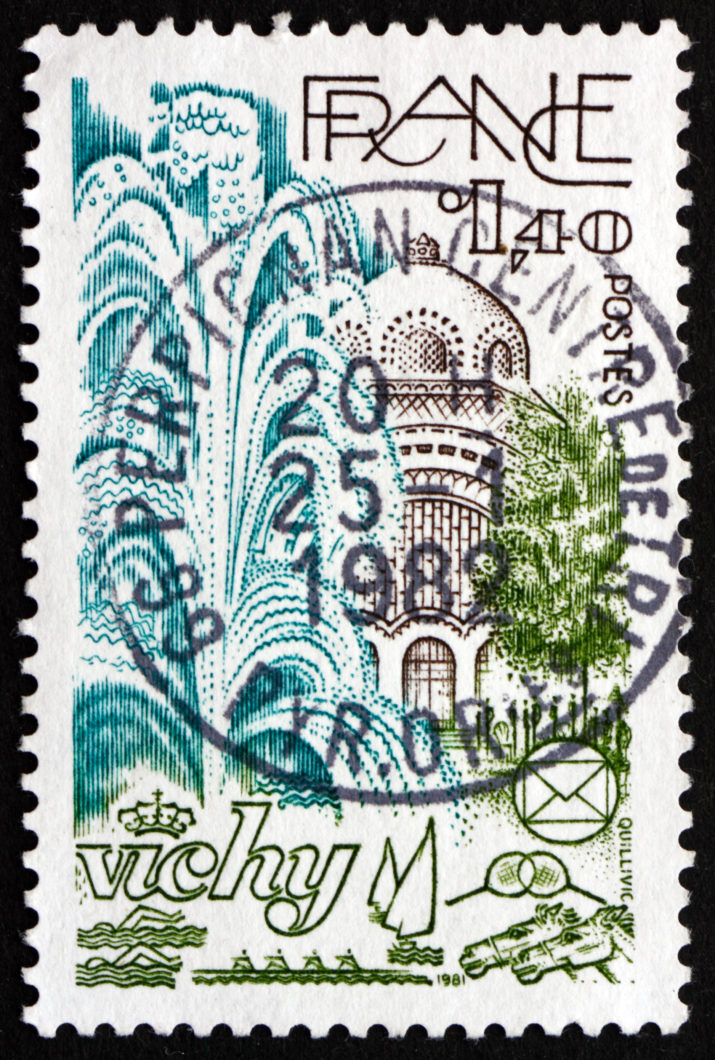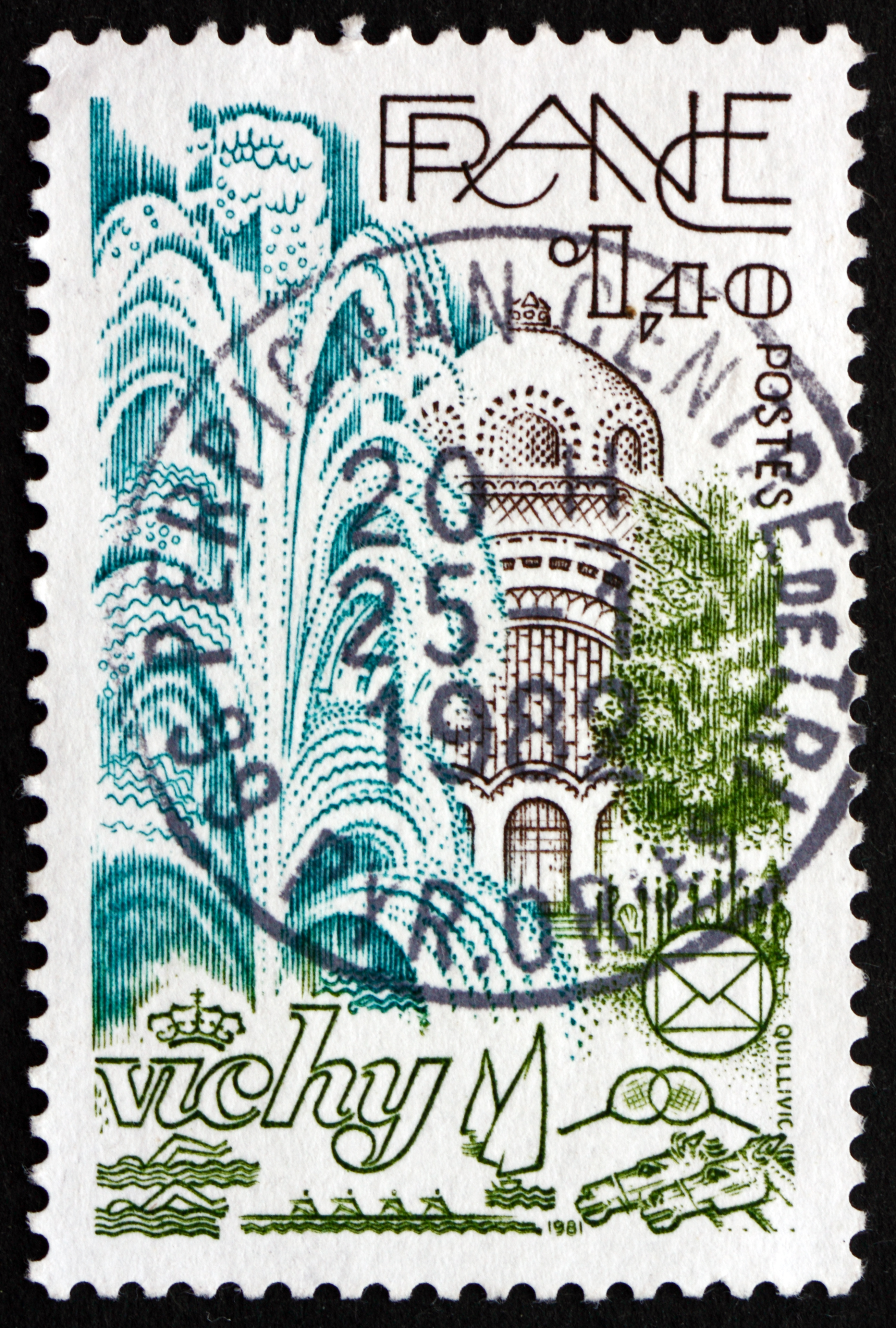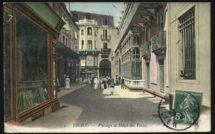
Author-Meets-Critics: Vichy contre Vichy, Une capitale sans mémoire by Audrey Mallet

An introduction to a roundtable, Author-Meets-Critics: Vichy contre Vichy, Une capitale sans mémoire by Audrey Mallet
Coping with dissonant remembrances of wartime France
Long before I studied l’Histoire de France in school, I knew Vichy. Vichy―the place—was where we sometimes stopped over as a family on the way back to Paris from vacation to visit the family vault at the cemetery (and stock up on the indispensable famous pastille that I would happily receive as candy). During the First World War, after being severely wounded on the war front, a certain poilu[1] was among the more than 140,000 battered bodies (representing five percent of all the wounded) to be sent for treatment behind the lines to this Art Nouveau spa town, which today is seeking recognition among UNESCO’s World Heritage sites under the collective label “Great Spas of Europe.”[2] Indeed, Vichy had the capacity to absorb a large soldier population (including Americans) in its hotels, which had been requisitioned by the government. Moreover, the military hospital established at the end of the nineteenth century benefitted from the latest technologies such as radiography, electrotherapy, and mechanotherapy to care for mutilated bodies arriving from the trenches on a scale never seen before (Chambriard 2012). Once discharged, this poilu―my great-grand-father―was unable to return to his northern Ardennes region, which had been largely destroyed and pillaged. Experienced in horsemanship and foundry, he found employment in a local forge and settled in Cusset, a then tiny locality on the outskirt of town. His wife and young daughters (among them my grand-mother), who had fled the family home with twelve million other civilian refugees in pedestrian convoys, eventually joined him. This story compares to that of many World War I displaced soldiers who are said to have paradoxically participated in generating interest for thermal tourism in Vichy and thereby written an essential page of the town’s history.
Unfortunately, just one generation later, history came to repeat itself with the Second World War. Again, Vichy would appear prominently in the family annals. The World War I veteran would have to take in his three daughters with children after their military husbands had been demobilized or made prisoners when the Marshal Pétain (“Verdun’s hero” who became head of the “Etat Français”) abolished the French Republic and arranged an armistice with the Germans that put an end to military combats in France. Two generations later, the wartime Vichy narratives that I grew up hearing are mostly based on the recollections of a boy―my father—who spent the war and after-war periods there, between the ages of five and eleven. In many ways, paying attention to these personal stories echoes Audrey Mallet’s (2019) effort in her recent book to scrutinize local amnesia and memory of everyday life in Vichy at the time of the Pétain régime, the arduous reconciling between personal and public memory, and the processes of remembering and forgetting as two sides of the same coin. In Vichy contre Vichy: Une capitale sans mémoire, Mallet seeks to fill a gap in the literature by examining the ways in which the Vichyssois (the inhabitants of the town, as opposed to the Vichystes, those who supported the régime headquartered in Vichy) have struggled to remember Word War II. Vichy-born herself, she sorts out the town’s inhabitants’ relationship with the Vichy that many without personal attachment to the place have vilified as the symbol of French capitulation and collaboration with the Nazis and, in the words of Charles de Gaulle, an illegitimate, null, and void régime.
Audrey Mallet’s book should certainly strike a deep chord for all who have lived those troubled times in the Queen of Spas, as well as in other places with a “dark” past. It clearly speaks to a collective and individual mnemonic dissonance, which I have personally experienced when first confronted with History with a capital H, certainly conditioning and shaping my academic interest in memory-making, albeit from a geographic perspective and with an emphasis on ways in which memory gets inscribed and transmitted (or erased and omitted) in the cultural landscape. For the “ordinary” population of Vichy, as elsewhere in France, the readily accessible memory of war seems to have been less about Pétain’s Etat Français than about surviving multiple penuries (food, coal, and miscellaneous merchandise) and trying to continue living “normally” through débrouille[3] and black market schemes, as particularly looking for food became a “constant obsession” (Mallet 2019, 31). Confirming Henri Lefebvre’s (1981) approach to everydayness as providing a multi-scaled entry into the “human praxis,” scholars have validated the relevance of testimonials of wartime everyday life. These narratives of the unimportant and the quotidian yield knowledge by bringing out the subjective experiences of ordinary people uninvolved in political decisions and by casting light on people’s social relationships, their rapport with their material world, and the ways in which national-level concerns become subordinate to the necessities of coping with daily uncertainties (Dodd and Lees 2018).
Mallet delved into the archives to unveil how Vichy the town has remembered Vichy the political representation of the collaborationist French State, highlighting the complex continuum between the outward collaboration of some among the population and civilian resistance (résistance passive). Today, people who can still speak in direct first-person accounts about this time in the history of the town were children then. Not necessarily equipped to grasp and accurately contextualize the on-going events, they were often not told about them, but encountered them on their own by catching snippets of muffled adults’ conversations or directly witnessing specific scenes that at the time may have lacked meaning for them. The memories that are passed on to the next generations via familial story-telling often originate in the intimate realm of emotions. They are the disorganized renderings of a war-world seen through the gaze of children who tried as best they could to make sense of it with limited information and maturity. It is by nature a selective pell-mell memory that mixes the important with the trivial and often remains acutely personalized, but that nonetheless nourishes general critical themes such as the nature of wartime propaganda, forms of resistance to occupation, and everyday subsistence in the face of privations.
“There are undoubtedly benefits to generalizing about the past; but to universalize is to depersonalize; and to depersonalize is to make the reality of lived experience alien to those who lived it” (Dodd and Lees 2018, 8-9). This comment suggests that accessing the past through someone else’s eyes can provide us with tools to understand its contemporary significance and its possible rewriting. When questioned (or not), my father remembers walking back from school and passing a building where the French Milice had posted graphic propaganda photos of murders that “terrorists” (in fact, résistants) had perpetrated. He recalls the time when supplies inspectors visited their house to check on the presence of black market goods, my great-grand-father sometimes getting paid in-kind at the forge by farmers in exchange for implements, such as a new plowshare. The same forge where he turned down an official request to make grenades by falsely advancing that it was too complicated a project. What strikes me every time is that, in the course of one same conversation, in which my father digs into his aging memory, he might comment on an apparently trifling detail about his shoes (for which the soles had been made out of articulated wooden pieces as a response to leather shortages), and also recount the dramatic times at the Liberation when he witnessed a cortege of women whose hair had been shaved to shame them for their “horizontal collaboration” (they had German lovers), as well as scenes of men accused of having collaborated being mauled. There is also the mysterious young man who lived in the attic for some time and that he would catch a glimpse of when he stepped outside in the garden only during the night. He learned much later exactly who that character was: the son of a résistant who had been killed, and a distant relative. He describes the times when, the ear tightly glued to the tube radio, he would listen to the enigmatic messages, coded for the Résistance, that were broadcast in French by the BBC-London―”completely forbidden,” he never fails to add with almost childlike mischievousness. In these reminiscences, the mundane and the ordinary easily mingle with the extraordinary, because, as Dodd and Lees (2018) explain, in war everything becomes extraordinary. As for any place, the wartime memory of Vichy―the town―has been imperfectly constructed out of a multitude of minute moments in the life of the anonymous people who were there.
While mine is a personal reaction to Audrey Mallet’s book and the question of post-war memory in Vichy, in this author-meets-critics round table, EuropeNow has convened outstanding scholars with expertise in the history of the spa town and wartime France to comment on the volume. As they place Mallet’s work in perspective with their own research, they help us reflect about how Vichy has lived its weighty heritage and waged the battle of conflicting memories. Richard Golsan lays the foundations of the conversation about remembering and forgetting Vichy. Then, while Gordon’s essay emphasizes the dichotomy between private and public memory, David Lees’ commentary addresses the dark legacy of Vichy as the “accidental capital” of Pétain’s régime. Both Richard Carswell and Kirrily Freeman underline how the past was rather deleted in Vichy in a defiant refusal to remember. Together, these five specialists interrogate how, caught in the cognitive tug between memory and amnesia, the Vichyssois can learn to remember in the twenty-first century, more than seventy-five years after the Liberation of France.
-
“Remembering and Forgetting Vichy” by Richard J. Golsan
-
‘Vichy contre Vichy: Memory and Forgetting – The Public and the Private” by Bertram Gordon
-
“The Town that Deleted its Past” by Richard Carswell
-
“The Dark Legacy of an Accidental Capital” by David Lees
-
“Vichy versus France: A Defiant Refusal to Remember” by Kirrily Freeman
Hélène B. Ducros is a human geographer whose research has focused on place attachment, sense of place, and heritage-making in rural France. At the Council for European Studies, she is EuropeNow’s Jean Monnet Chair of Research and Pedagogy and co-chairs the newly formed Critical European Studies Research Network, which gathers scholars and educators interested in sharing best practices and examining issues of studying, teaching, and learning in and about Europe (@CESCritEuro).
References
Chambriard, Pascal. 2012. “1914-1918 : Vichy soignait les blessés du front.” La Semaine de l’Allier, November 17. Accessed November 17, 2019. https://www.lasemainedelallier.fr/2012/11/17/1914-1918-vichy-soignait-les-blesses-du-front/
Dodd, Lindsey, and David Lees, eds. 2018. Vichy France and Everyday Life: Confronting the Challenges of Wartime, 1939-1945. London: Bloomsbury Academic.
Lefebvre, Henri. 1981. Critique de la vie quotidienne. Paris: L’Arche Editeur.
Mallet, Audrey. 2019. Vichy contre Vichy: Une capitale sans mémoire. Paris: Belin.
[1] Name given to French WWI soldiers.
[2] To know the other ten European cities that are part of the collective, visit: http://www.vichy-patrimoine-mondial.com/gse/
[3] Coping, making do, managing in the face of some adversity.
Photo: FRANCE – CIRCA 1981: a stamp printed in the France shows Public Gardens, Vichy, City in the Auvergne Region | Shutterstock
Published on November 15, 2019.




